Write Us
We are just a call away
[ LET’S TALK AI ]
X
Discover AI-
Powered Solutions
Get ready to explore cutting-edge AI technologies that can transform your workflow!

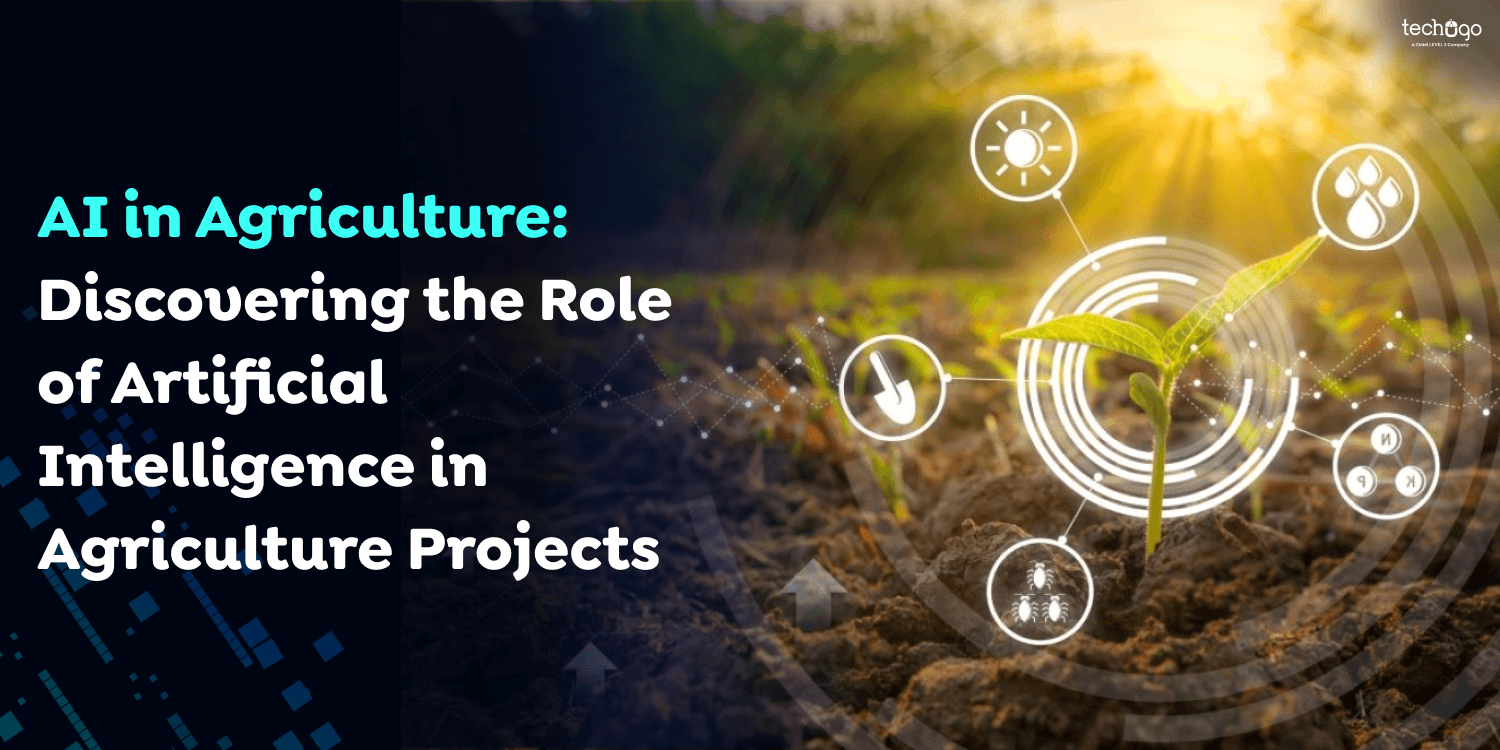
These are only a handful of the figures discovered by a quick Google search for the ‘global digital agriculture market.’ Not sure if these numbers are correct or not. What’s quite clear from these figures, as well as other research-based statistics, is that there is a market for collecting information and generating structured data by using many IoT sensors as well as artificial intelligence (AI) or machine learning (ML) devices required to analyze the data and transform into valuable recommendations’, is massive and growing continuously.
With the diverse variables involved in cultivating crops and raising animals, the role of artificial intelligence in agriculture projects is among the top fertile sectors for developing these technologies. It is clear the areas where IoT monitors, AI and ML are already affecting the world today, but as we witness the rapid advancement and spread of AI everyday life via ChatGPT and other models of language that are based on chatbots, there is a that range and impact of AI in agriculture will expand quickly.
It is crucial to know about the benefits of AI in agriculture. However, before we understand artificial intelligence and agriculture-related projects, let’s examine the present state of the agricultural industry.
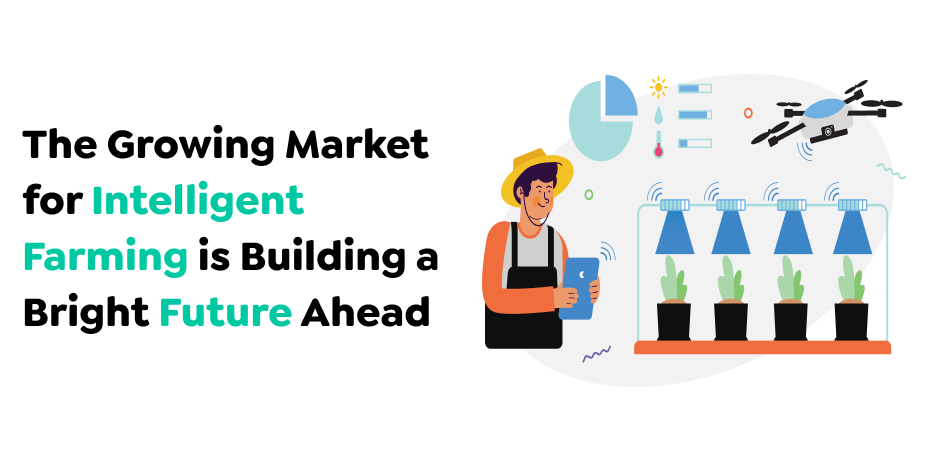
The continuing research and development are ongoing to utilize the latest technologies in agriculture. With all the excitement about AI and its applications across various sectors, here are a few figures regarding AI in the market for agriculture:
Based on the forecasted numbers, what lies ahead for AI in agriculture appears positive—one that focuses on sustainability, innovation, and efficiency. It will harness AI’s capabilities to build an enduring and productive landscape for agriculture.
Also Read : Seeding the Future of Agriculture in Saudi Arabia: An AgriTech Boom
AI can assist the food industry in reducing expenses, improving yields, and effectively providing food to billions of people. Here are a few examples of artificial intelligence-driven tools transforming how we farm.
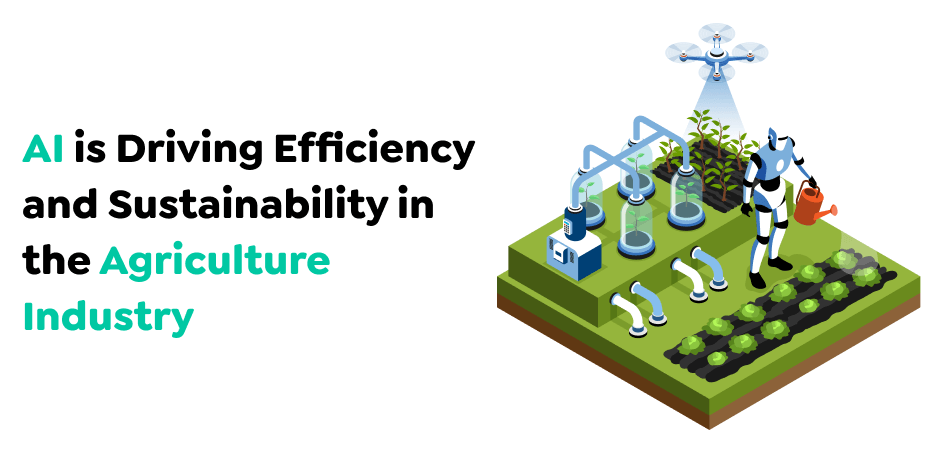
Machine learning is when computers imitate human behavior and adapt and change according to inputs. The accuracy of predictions for outcomes increases when the machine expands and grows. In agriculture, ML technology can boost crop yields in many ways. ML can analyze sensor data and past patterns to forecast crop yields. It can help determine the cost of production, make suggestions on pesticides, and the list goes on.
When used in the pre-harvesting phase, machine learning can help breed crops that make them more tolerant to temperature fluctuations and droughts, in addition to others. Machine learning can also recognize plant diseases, weeds, and pests. It can also apply precisely applied spraying to a region using a suitable herbicide.
Cognitive computing in agriculture can be utilized to understand and interact with various environments to boost productivity. In the field of agriculture, the cognitive computer utilizes predictive models to predict agriculture-related issues like the effects of drought, weather, or pollution. Farmers can take preventive measures to safeguard their crops, limit losses, and reap more yields when ready for these issues.
One of the most popular Internet of Things (IoT) applications is precision farming, which analyzes historic weather patterns to provide information on rain, soil, and insect pests. Strategies like site-specific crop management (SSCM) use automated seeders to yield the greatest while not draining soil.
Artificial intelligence sensors can also be used to attain precision farming, which permits farmers to concentrate on the particular weeds and pests in certain zones rather than spraying all fields. This allows for efficient use of chemicals, water, and other sources. Precision farming is also used for irrigation and fertilization, allowing for a perfect balance of resources that yields the healthiest and largest crops.
Also Read : How To Develop An IoT Application: Features, Benefits, and More!
Drone photography monitors the fields and crops to assist farmers in increasing their production while providing them with real-time analytics and other details. Drones can collect aerial data, use sensors to assess it, and provide interactive reports for farmers. Farmers can swiftly get information on areas where the soil is being eroded or areas with inadequate drainage, which can lead to flooding, allowing for an increase in soil fertility and land efficiency resources.
Also Read : Get Multiple Agriculture Benefits with Security Drones for Farms
The supply chain worldwide is a highly stressful process, and agriculture isn’t different. Any delay within the supply chain of agricultural products could result in devastating negative consequences. AI can assist in enhancing supply chains, transport and logistics, and reducing consumption and by collaborating with top mobile app development company in India, you can easily build an app related to the agriculture industry.
AI can also help unify systems, allowing for greater transparency and accessibility between suppliers. Monitoring and updates in real-time facilitate rapid communication and a solution-focused approach throughout every supply chain step. AI can also enhance security. The food supply chain is an extremely delicate and highly interconnected system. It can’t afford to lose time to attacks via cyberspace.
Also Read : The Impact of Web and Mobile Apps on Sustainability in the Event Industry
Humankind has made significant strides since the first agricultural revolution, which began around 10,000 B.C. The role of artificial intelligence in agriculture projects has been described as the silent revolution that has changed traditional farming practices.
In the present era, where tradition and technology harmoniously exist, AI emerges as a critical factor shaping every aspect of the agricultural lifecycle. From the preparation of soil to sowing as well as harvesting, irrigation, and even storage, here’s how AI can seamlessly integrate throughout the agricultural lifecycle.
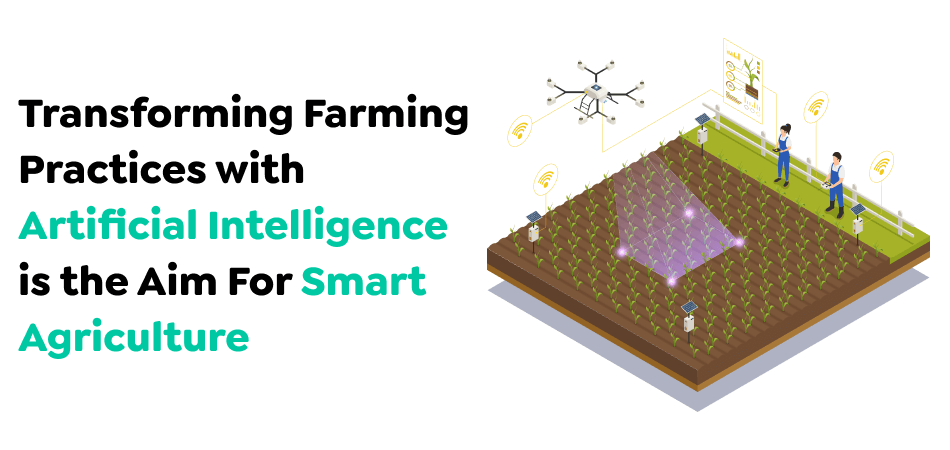
Without AI or other technology in this procedure, farmers have to deal with uncertainty, second-guessing, and more when prepping the soil. It was more of an art than a science, as farmers relied on their instincts, backed by years of soil experience, to determine the various aspects of soil preparation, including plowing, tilling, incorporating organic matter, creating narrows and ridges, and much more.
The crop will be responsible for the cost of inaccuracy! In the age of AI, it’s no longer speculation – precise data guides their choices!
Artificially powered soil sensors or AI-driven machines with smart sensors can collect actual data from the soil. Furthermore, AI algorithms study the soil’s chemical makeup and provide insights into the leading indicators of soil composition, including the levels of nutrient content and moisture content. Additionally, AI algorithms can examine historical weather data and predict future trends.
Farmers can use this information instead of relying on their intuition and experience to make educated decisions about selecting the best mixture of organic matter to prepare for planting.
Its outcome? A perfect soil for seeds that promise a large crop!
After the farmer has prepared the soil, it’s time to sow the seeds. While it was confirmed that the Green Revolution transformed agriculture with high-yielding varieties (HYV) seeds and mechanized farming tools and many more, farmers were able to overcome the problem of precisely sowing the seed (at an exact space and a certain depth) through the use of seed sowing machines. However, they did not have any other option than the suppositions of others when determining the most optimal time to sow.
Here’s how ai can be used in agriculture:
The first thing to do is that farmers can utilize AI algorithms to study past weather data to gain insight into the most favorable times for sowing seeds, removing the risk of using traditional calendars. These AI-powered systems are created with the help of an AI app development company to provide timely alerts in the event of sudden rainfall or temperature changes.
While HYV seeds are said to give farmers a surplus of production, soil composition and weather conditions can impact the quantity of the crop. Machine learning algorithms can be utilized to offer personalized recommendations for the best-suited varieties of seeds by analyzing the above-mentioned factors.
Additionally, farmers can utilize drones powered by AI to map and scan the fields with amazing depth. This can be used to direct automatic seed-sowing equipment or machines to ensure a uniform distribution across the field.
When adding fertilizers, farmers are often faced with the problem of “too much or too little.” The excessive use of fertilizers can cause pollution from nutrient runoff and harm crops. Studies have shown that 75 million tons of nitrogen fertilizer used on plants run off into our lakes, rivers, and natural ecosystems. The lack of fertilizer supplies causes the soil to overuse its naturally available nutrients, making it unproductive throughout the duration of agriculture.
To avoid this apprehension and doubts about fertilizer mixes, AI algorithms can provide a personalized percentage of fertilizers for the soil based on the soil’s nutrient level and crop needs. Similar to the process of soil preparation, AI algorithms are employed to obtain accurate information about the various aspects of soil. They are also used to determine the amount of nutrients in the soil.
Also Read : Driving Progress: The Rise of Software Development in the Middle East
With 70% of the water withdrawals made for farming, the agriculture industry is the most likely source of water shortages in the next few years. Traditional irrigation practices can result in inadequate or excessive irrigation, which can cause crop damage and waste of fresh water. Nowadays, the optimal utilization of water is a problem farmers are seeking solutions to.
The role of artificial intelligence in agriculture projects can decrease the agricultural water footprint dramatically.
AI-powered app solutions, sensors, algorithms, equipment, and much more can be utilized in the following areas of irrigation.
In addition to diseases, Plant pathogens can affect the overall health of the plant. Of the average loss of 36.5%, approximately 14.1% is due to illnesses, 10.2% from insects, and 12.2% from weeds. If it’s stress based on water insects-related diseases, deficiency nutrients, or any other stress the crop is experiencing, being aware of it early will allow farmers to implement measures to prevent the situation from getting worse.
By implementing AI cultivation, growers can increase the level of monitoring for plant health. They can gain from AI-based solutions, such as AI-powered sensors or drones for real-time medical monitoring, AI-powered picture recognition, disease detection AI applications, and many more.
Worldwide, about 1,800 types of weeds reduce plant growth by around 31.5 percent, which results in an annual economic cost of around $32 billion. Plants that receive fewer nutrients and sun from weeds also become more susceptible to pest attacks. This increases the expense of herbicides and the efforts to put them in the fields to eradicate the weeds.
Bots with computer vision that utilize the capabilities of AI and machine learning will help farmers automatically remove weeds and provide more rapid detection. Bots can also precisely estimate the amount of herbicide required in the field by analyzing different criteria such as weed density, crop type dimension, field size, and much more.
Intelligent sprayers allow for efficient control of how much herbicide is sprayed on weeds, decreasing the amount of herbicide wasted or not used. The goal of applying herbicide will yield savings in costs and better removal of herbicides.
It’s always been one of the most labor-intensive, costly, and time-consuming jobs throughout the lifecycle. There was also the risk of over-ripening when harvesting too late or crops becoming premature when harvested too early. Farmers often relied upon visual inspection (prone to error) to determine the ripeness of their crops.
Here’s what is the role of artificial intelligence in agriculture projects could help with harvesting:
The primary concern following harvest is the preservation of harvested goods. Produce that is stored after harvest is exposed to the environment’s conditions, the unpredictability of pests, and the constant risk of spoilage. When it is affected by any one of these, the food becomes less palatable and ultimately loses its value on the market. The longevity of the product can only be maintained through consistent and accurate monitoring and control of the storage conditions.
Here are a few examples of artificial intelligence applied to agriculture that may help farmers revolutionize their method of storing harvested crops:
The role of artificial intelligence in agriculture projects is more than an advancement in technology; it is a paradigm shift in how farmers think about these processes.
Also Read : Here’s Why The World Is Excited About Introduction Of Tech In Agriculture
Artificial intelligence (AI) is causing revolutions in the world of agriculture. AI technology is revolutionizing farming practices and giving farmers access to previously unobtainable knowledge and resources that will increase yield sustainability. Through AI, also known as artificial intelligence, farmers can better manage resources like fertilizer, irrigation, and pesticides, thereby reducing the amount of waste they generate and their impact on the environment while increasing the yield.
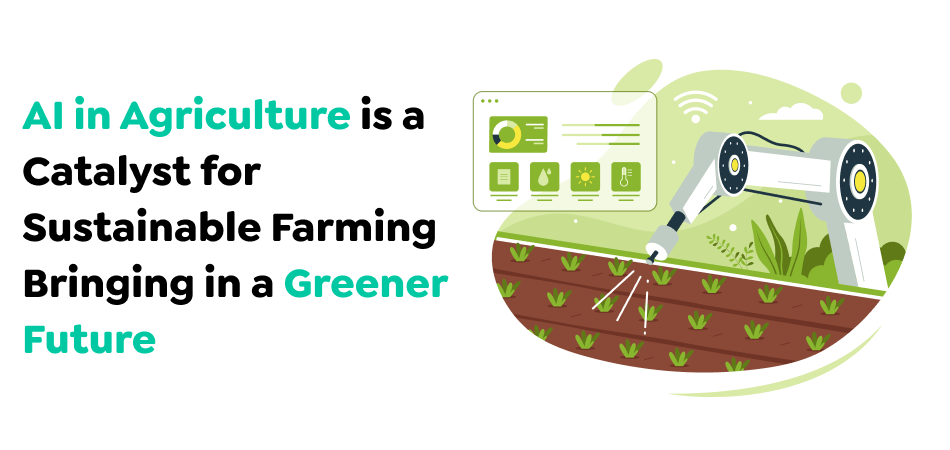
AI-driven crop monitoring and disease detection systems can detect problems earlier, allowing farmers to implement preventative measures to safeguard their crops and limit losses. Farmers can make informed decisions about planting, harvesting, and managing their crops using AI-powered predictive analytics, which improves the distribution of resources and decreases risks.
Artificial Intelligence (AI)-powered smart irrigation devices ensure water is used efficiently according to current data on environmental conditions and crop demands, safeguarding water resources and maximizing yields.
Additionally, the development of artificial intelligence-driven, autonomous farm equipment simplifies processes, cuts labor costs and boosts production. In a nutshell, Artificial Intelligence (AI) is revolutionizing the agriculture industry by offering farmers data-based solutions to tackle the problem of feeding the increasing world population while also reducing environmental impact. Let’s examine the many ways AI is revolutionizing the agricultural sector.
Precision Agriculture, often known as satellite agriculture or site-specific crop management, is a way of managing agriculture that increases the yields of crops and profits while minimizing environmental impacts and waste. It uses Artificial Intelligence (AI) in combination with Internet of Things (IoT) technologies.
For farmers to provide vital information on soil health and moisture levels and pests and the progress of their crops and other developments using Artificial Intelligence (AI) powered algorithms examine data from various sources, like sensors, drones, satellites, and older data. Farmers can make the most of their resources and reduce expenses. They can also reduce the environmental effects of their activities by limiting inputs like fertilizers, water, and insecticides.
Water scarcity is an important issue facing the modern agricultural system, which is challenged by climate changes and increasing water demand. AI-powered intelligent irrigation systems can provide a green solution by optimizing the amount of water used in accordance with the environmental conditions and water requirements.
Sensors for soil moisture, weather forecasts, and AI algorithms continually alter irrigation schedules to ensure crops get the correct amount of water at the proper time. Reduces water wastage and the amount of runoff produced; innovative irrigation systems help conserve water resources while increasing the yields of crops.
Artificial Intelligence, Machine Learning and algorithms for image recognition enable early detection of disease and insect infestations as well as real-time monitoring of the condition of the crops. Drones equipped with cameras feature high-resolution cameras that capture aerial images of farms. These images are then connected to AI algorithms to identify irregularities like color changes in leaves, uneven growth of plants, or signs of an infestation. If issues are detected early, farmers can implement corrective actions to prevent disease spread and limit productivity loss. This includes rotation of crops, as well as focusing spraying.
One of modern agriculture’s biggest problems is the need for more water. This is aggravated by the changing climate and increasing water demands. Smart irrigation systems based upon artificial intelligence are a viable method of optimizing water use based on the requirements of the crops and the most recent information on the environment.
The correct quantities of water are distributed to crops at the appropriate time because of the possible flexible irrigation schedules thanks to sensors to measure soil moisture AI algorithmic processes and forecasts of weather. Smart irrigation systems boost crop yields while preserving precious water resources by reducing runoff and water waste.
Farmers can make informed decisions regarding planting, cultivation, and harvesting using Artificial Intelligence-powered predictive analytics. AI machines can offer precise predictions on yields of crops, optimal planting times, and possible risks, such as droughts or pest outbreaks, through analyzing historical, past, and present information, forecasts of soil and weather conditions, and market trends. Farmers can improve their productivity and profits by altering their farming practices, distributing resources efficiently, and reducing the chance of risk.
Artificial intelligence (AI) is an essential element in establishing the sustainability of farming practices to maximize the use of resources, reduce the environmental impact, and promote biodiversity in the ecosystem. AI algorithmic systems can offer suggestions to improve precision farming practices as also practices for conservation and crop rotation that increase the fertility of soils as well as reduce the need for chemical usage and increase ecological resilience via the study of soil health, as well as the patterns of weather and indicators of environmental health.
Farmers can meet the increasing demand for ethical and sustainable goods while protecting the environment for the coming generations by integrating AI-driven sustainability practices into their everyday operations.
Also Read : How Much Will Mobile App Development Cost in 2025?
The agriculture industry faces various problems, including a need for adequate irrigation systems, issues with weeds, plant monitoring because of crop height, and extreme weather conditions. However, efficiency is enhanced through the use of technology, so these issues are solvable. The performance can be improved through various AI-powered techniques, such as remote sensors for soil moisture detection and automated irrigation made possible by GPS.
The issue facing farmers was that precision weeding methods overcame the massive amount of crops lost during weeding. These autonomous robots increase effectiveness; they also cut down on the use of unnecessary herbicides and pesticides.
Farmers can also easily spray herbicides and pesticides on their farms using drones. Plant monitoring is no longer an issue. In the beginning, the lack of jobs and resources is easily understood through AI in the farming industry. In the traditional methods, vast amounts of work were required to gather characteristics of crops like plant size, soil texture, and soil texture, and in this way, manual testing took place, which was very tedious.
With the aid of various techniques, fast and unaffected high-throughput Phenotyping could be achieved with the advantage of being an adaptable and beneficial activity and on-demand access to information and spatial objectives.
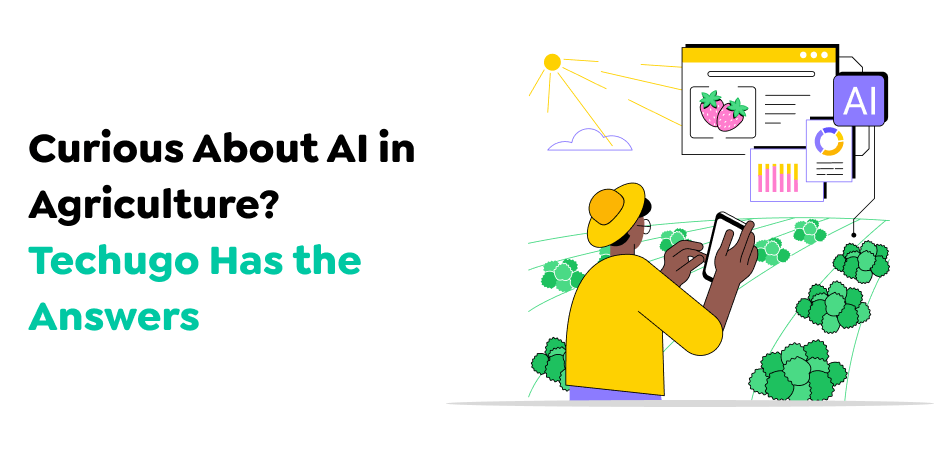
Techugo, a leading AI app development company, could be the ideal partner for businesses looking to leverage AI in agriculture. With a proven track record of success in developing innovative AI-powered solutions, Techugo can help you address the challenges facing the agriculture industry. Our team of experts can create custom AI apps tailored to your specific needs, such as remote sensing for soil moisture detection, automated irrigation, precision weeding, drone-based herbicide and pesticide spraying, and high-throughput phenotyping. By partnering with Techugo, you can gain a competitive edge and unlock the full potential of AI in your agricultural operations.
Get in touch with Techugo today!
Write Us
sales@techugo.comOr fill this form